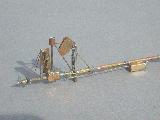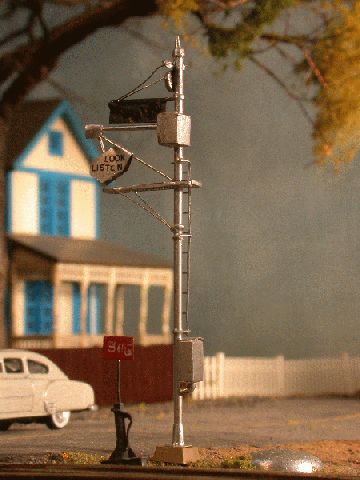New England Railroad History and Modeling Page
Copyright 1999 - 2021 by James
B. Van Bokkelen . This document may be duplicated and distributed
for non-commercial purposes only, all other rights reserved.
Maintained by James B. VanBokkelen (jbvbREMOVETHIS@jbvb.us).
(NOTE:"REMOVETHIS" is intended to out-smart spam
robots. You should do so in order to e-mail me).
This area has material on New England railroading in general, with
links to the Bangor & Aroostook, Boston & Maine, New Haven and
Maine Central content. I started to spread out beyond the B&M when
a project left me with some machine-readable information on New Haven
heavyweight cars which I don't think is easily available from other
sources. I'll add more as need arises.
In case you need to look elsewhere,Railserve has a broad focus,
with North American and international railroading. Trains Magazine has a
Train Magazine Index. This
requires registration and as of March 2011 includes only Kalmbach
publications. The NMRA Magazine
Index (location may change as it matures) is more in the spirit of
Jeff Scherb's original effort. The NMRA Directory of World Wide Rail
Sites seems to have fallen by the wayside.
I have a number of high-resolution close-up photographs of my
models in my gallery .
 The Union Switch and Signal
Style 'DW' Automatic Flagman is the less common kind of
wig-wag crossing signal. Most of the wig-wags in North America were
Magnetic Flagmen installed by the Harriman roads in the Southwest.
The US&S version was used by the Erie and Canadian Pacific, among
others. In New England, both the B&M and Maine Central used it,
often with a semi-circle of five lights on a rectangular panel
mounted above the wig-wag itself.
The Union Switch and Signal
Style 'DW' Automatic Flagman is the less common kind of
wig-wag crossing signal. Most of the wig-wags in North America were
Magnetic Flagmen installed by the Harriman roads in the Southwest.
The US&S version was used by the Erie and Canadian Pacific, among
others. In New England, both the B&M and Maine Central used it,
often with a semi-circle of five lights on a rectangular panel
mounted above the wig-wag itself.
I derived the following dimensions by measuring one of the
photographs of the Wilton, NH signal on
the
Dansrailpix wig-wag page. The preserved wig-wag at North Conway,
NH isn't the same style. My fundamental assumption was a height of 20
feet to the base of the finial, estimated from photos. The Wig-Wag
page says that the signal was about 24 feet tall, but at the time it
seemed to me that the one at Rowley was a bit shorter. After
finishing and installing it, I think the Wig-Wag page was probably
right, so I've re-worked the proportions below for 24 feet.
- 23 feet to angle supporting flasher guy wires.
- 21 feet 6" to bell centerline
- 20 feet to flasher support arm, flasher arm 50" long.
- 18 feet to bottom of mechanism box, box 24" high by 16" square.
- wig-wag arm 5 feet long, measured from side of box.
- 16 feet to base of wig-wag arm brace
- 15 feet to platform, platform 60" long by 15" wide.
- 12 feet to base of platform brace.
- 6 feet to bottom of ladder.
- 2 feet to bottom of relay case mounting bracket.
The B&M's Eastern Route line through Rowley, Massachusetts was
protected by a DW wig-wag in the early 1950s. I needed one for my HO
scale module, and because there was no commercial offering, I
scratchbuilt it from brass using a resistance soldering setup. For HO
scale, I used 0.625 inch tube for the mast, .032 piano wire for the
wig-wag arm and 3/16" channel for the boxes. I sliced the 0.625
inch tube at a 60 degree angle to make the flasher lamp housings and
lens shades. The rest of the model is built from a mix of .012 wire,
.010 by .030 strip and .005 brass sheet. The ladder and platform
grating are etchings from the out-of-production Free State Systems
#8001-1 Signal Ladders and Platforms set. My model took about three
evenings to get to this point.
 In the 1920s and 1930s, the B&M painted its
signals and grade crossing warning devices black. During the 1940s
they switched to aluminum paint, and that's the scheme I chose,
brushing on Floquil Bright Silver. The
LOOK and LISTEN were lettered with decals. I made the
foundation of styrene, drilled it for the mast, and painted it with
Floquil Foundation. This photo shows my wig-wag after a couple
of years of traveling to train shows (which is why I used brass and
solder instead of styrene or ACC).
In the 1920s and 1930s, the B&M painted its
signals and grade crossing warning devices black. During the 1940s
they switched to aluminum paint, and that's the scheme I chose,
brushing on Floquil Bright Silver. The
LOOK and LISTEN were lettered with decals. I made the
foundation of styrene, drilled it for the mast, and painted it with
Floquil Foundation. This photo shows my wig-wag after a couple
of years of traveling to train shows (which is why I used brass and
solder instead of styrene or ACC).
Maintained by James B. VanBokkelen.
 The Union Switch and Signal
Style 'DW' Automatic Flagman is the less common kind of
wig-wag crossing signal. Most of the wig-wags in North America were
Magnetic Flagmen installed by the Harriman roads in the Southwest.
The US&S version was used by the Erie and Canadian Pacific, among
others. In New England, both the B&M and Maine Central used it,
often with a semi-circle of five lights on a rectangular panel
mounted above the wig-wag itself.
The Union Switch and Signal
Style 'DW' Automatic Flagman is the less common kind of
wig-wag crossing signal. Most of the wig-wags in North America were
Magnetic Flagmen installed by the Harriman roads in the Southwest.
The US&S version was used by the Erie and Canadian Pacific, among
others. In New England, both the B&M and Maine Central used it,
often with a semi-circle of five lights on a rectangular panel
mounted above the wig-wag itself. In the 1920s and 1930s, the B&M painted its
signals and grade crossing warning devices black. During the 1940s
they switched to aluminum paint, and that's the scheme I chose,
brushing on Floquil Bright Silver. The
LOOK and LISTEN were lettered with decals. I made the
foundation of styrene, drilled it for the mast, and painted it with
Floquil Foundation. This photo shows my wig-wag after a couple
of years of traveling to train shows (which is why I used brass and
solder instead of styrene or ACC).
In the 1920s and 1930s, the B&M painted its
signals and grade crossing warning devices black. During the 1940s
they switched to aluminum paint, and that's the scheme I chose,
brushing on Floquil Bright Silver. The
LOOK and LISTEN were lettered with decals. I made the
foundation of styrene, drilled it for the mast, and painted it with
Floquil Foundation. This photo shows my wig-wag after a couple
of years of traveling to train shows (which is why I used brass and
solder instead of styrene or ACC).